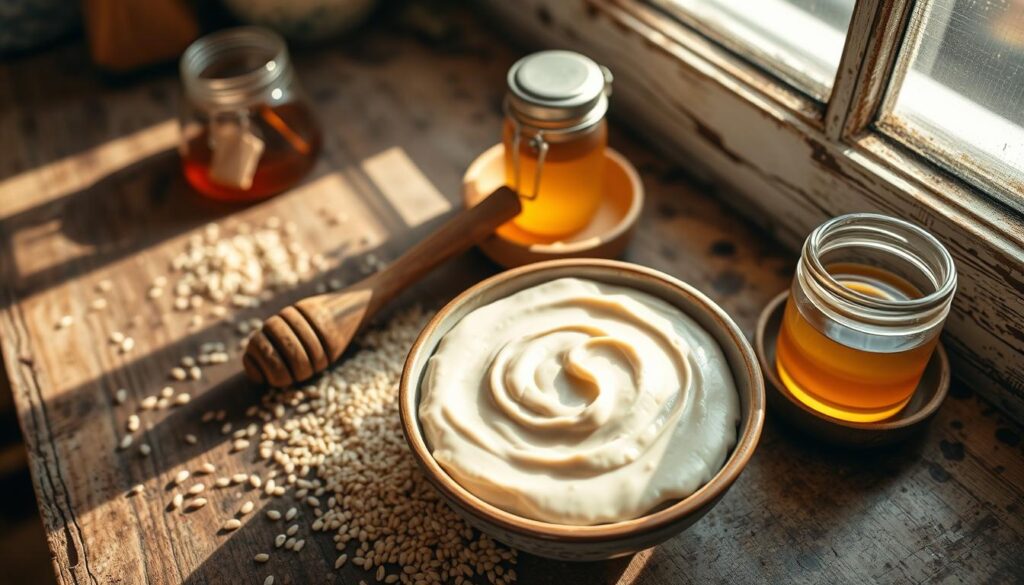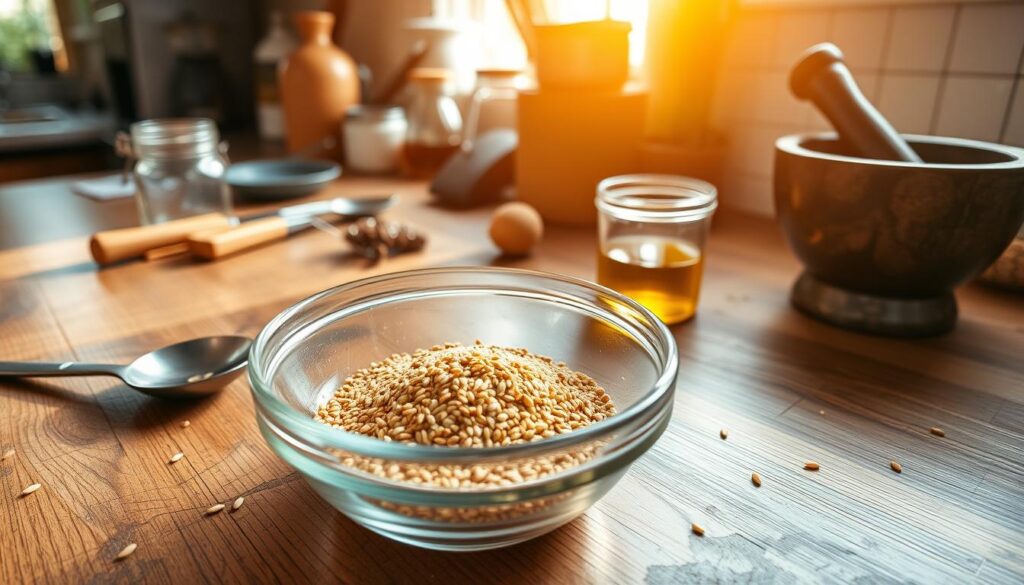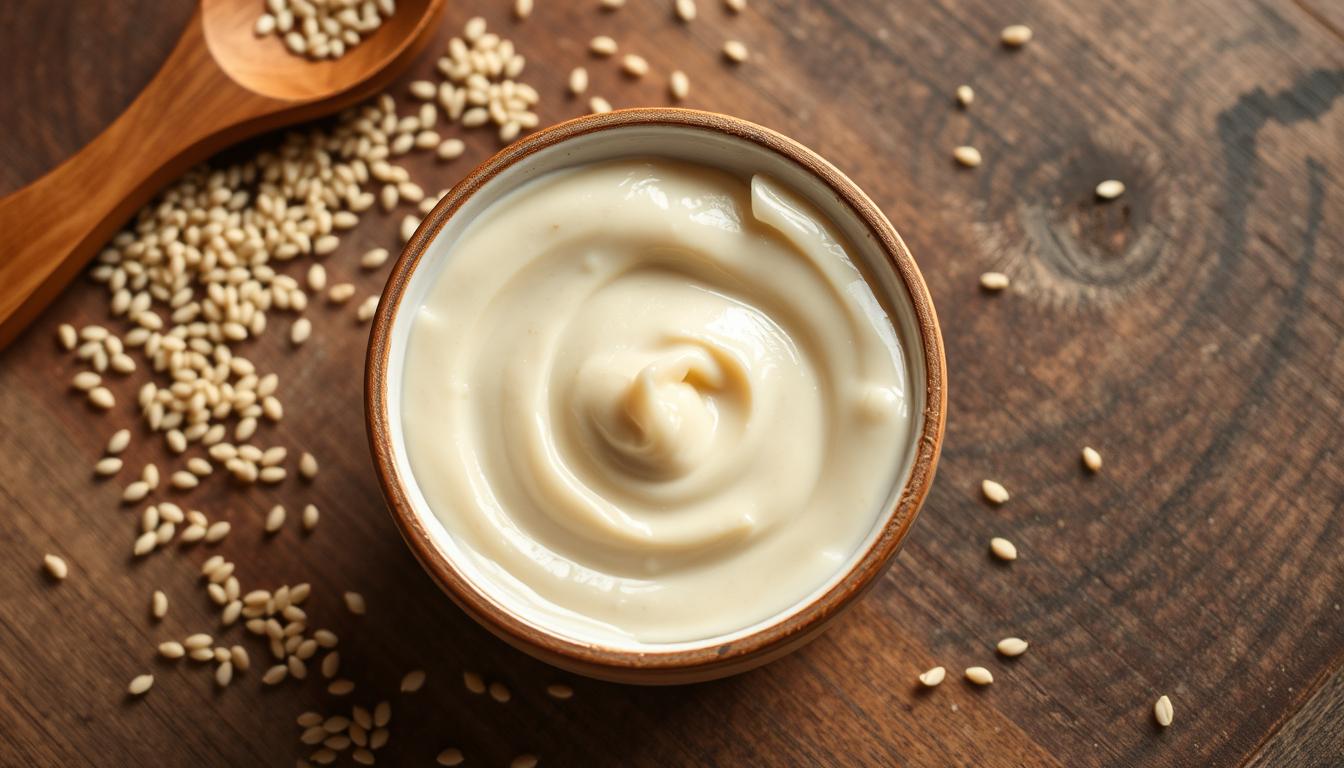I love cooking at home and always look for new flavors. Sesame paste’s rich, nutty taste caught my eye. But finding it in stores was expensive and hard to find. So, I decided to make it myself.
Making sesame paste at home is simple and quick. You can have it ready in just 15 minutes. It’s perfect for many dishes, like Taiwanese cold noodles and Sichuan dan dan mian. Plus, you can adjust the flavor to your liking. Interested in mastering Recipe for Sesame Paste? Start with these ideas!
Table of Contents
Key Takeaways
- Homemade sesame paste can be prepared in just 15 minutes
- The paste can be stored in the refrigerator for up to 1 month
- Sesame paste is a versatile ingredient used in various Asian dishes
- Making your own paste allows you to control the quality and flavor
- Buying sesame seeds in bulk is a cost-effective way to make the paste
What is Sesame Paste?
Sesame paste, also known as tahini in the Middle East or zhima jiang in China, is a tasty ingredient. It’s made by blending toasted sesame seeds with oil. This creates a creamy, nutty condiment that makes many dishes better.
Understanding the Ingredients
The main parts of sesame paste are toasted sesame seeds and oil. Unlike tahini, sesame paste is toasted more, giving it a deeper flavor. The oil used can change the taste, with sesame oil adding more nuttiness or olive oil making it milder.
Nutritional Benefits
Sesame paste is packed with nutrients. It’s full of protein, healthy fats, and minerals like calcium, iron, and magnesium. Adding it to your Mediterranean cuisine or Middle Eastern condiment makes your meals healthier.
| Nutrient | Amount per 2 tablespoons (30g) |
|---|---|
| Calories | 178 |
| Total Fat | 16g |
| Protein | 5g |
| Calcium | 64mg |
| Iron | 1.5mg |
“Sesame paste is a staple ingredient in many Middle Eastern and Mediterranean cuisine dishes. It adds a rich, nutty flavor and creamy texture to dips, dressings, baked goods, and savory entrees.”
Why Make Your Own Sesame Paste?
Making your own vegan-friendly spread, nutritious dip, or protein-rich paste at home is rewarding. It ensures freshness and flavor. Plus, it’s cheaper than buying it from stores.
Freshness and Flavor
When you make sesame paste at home, you control the ingredients and flavors. You can adjust the taste to your liking. This way, you avoid preservatives and additives found in store-bought versions.
Cost-Effectiveness
Buying sesame seeds in bulk and making your own paste saves money. It’s great if you use sesame paste a lot. You can also try different flavors without spending a lot.
Homemade sesame paste offers a fresher, tastier, and cheaper option. By making it yourself, you unlock its full flavor. Enjoy the benefits of your creativity in the kitchen.
Essential Ingredients for Sesame Paste
To make a tasty homemade sesame paste, you need two main ingredients: sesame seeds and oil. The type of sesame seeds and oil you pick can change the taste and texture of your paste.
Sesame Seeds: Types and Varieties
Choose white, hulled sesame seeds for the best taste. You can find these in bulk at Asian or Middle Eastern markets. They give a smoother paste than unhulled seeds, which can taste bitter or nutty.
While you can try other sesame seed types, white hulled seeds are the classic choice. They’re perfect for making a traditional sesame paste or tahini.
Oil Options for Creaminess
There are a few oil choices for your sesame paste. A neutral vegetable oil like sunflower or grapeseed oil lets the sesame flavor stand out. A light olive oil can also add a subtle richness.
Stay away from strong oils like extra virgin olive oil. They can mask the sesame taste. Pick an oil that enhances the sesame paste without overpowering it.
“Homemade sesame paste allows you to control the quality and freshness of the ingredients, ensuring a more flavorful and nutritious final product.”
Step-by-Step Process to Make Sesame Paste
Making your own recipe for sesame paste at home is a fun journey. The secret to great homemade sesame butter is in the steps. Let’s explore how to make your own creamy and tasty sesame paste from scratch.
Toasting the Sesame Seeds
Start by toasting the sesame seeds to bring out their rich, nutty smell. Heat a dry skillet over medium-low heat and add the sesame seeds. Stir them often until they’re golden brown and smell great, which should take about 4 minutes.
Once they’re toasted, move them to a plate. Let them cool completely, which will take about 10 minutes.
Blending Techniques for Smoothness
Now, turn the toasted sesame seeds into a smooth paste. Put the cooled sesame seeds in a food processor and start blending. It might take a few minutes, so be patient.
Add sesame oil slowly, starting with 1/4 cup, while blending. Keep blending and scrape down the sides of the bowl to mix everything well.
Adjust the oil as you go to get the right consistency. The paste should be silky smooth and creamy. You’ll get about 1/2 cup of sesame paste, with each serving being about 1 tablespoon.

“The secret to the perfect homemade sesame butter lies in the patient blending process. Keep at it, and you’ll be rewarded with a luxuriously smooth and flavorful paste.”
Follow these steps to make your own delicious recipe for sesame paste. Enjoy the joy of making a versatile ingredient that can make many dishes better.
Flavor Variations to Try
Get creative in the kitchen with homemade sesame paste. You can make it sweet, spicy, or anything in between. Whether you’re a pro or just starting, these ideas will help you make a sesame paste that’s just right for you.
Adding Sweeteners
Try adding honey or maple syrup for sweetness. These natural sweeteners enhance the sesame seeds’ nutty taste. Start with 1-2 tablespoons per cup and adjust to your taste.
Incorporating Spices
Add spices like cinnamon, cardamom, or za’atar for a unique flavor. Start with a small amount and add more until it tastes just right.
For a twist, mix in toasted peanuts with the sesame seeds. This creates a tasty peanut and sesame mix. Adjust the oil to get the right consistency.
Homemade sesame paste is all about personal taste. Be bold and try new flavors. You’ll get a versatile condiment that’s great in many dishes.
Storage Tips for Homemade Sesame Paste
Keeping your homemade sesame seed paste ingredients fresh and flavorful is key. Whether you’ve made fragrant homemade sesame butter or smooth sesame paste, storing it right is important.
Best Containers for Freshness
An airtight glass jar is the best container for your homemade sesame paste. Glass jars keep the paste’s texture and prevent air from getting in. This stops it from drying out or getting bad tastes. Stay away from plastic containers, as they can give off bad smells or tastes.
Shelf Life and Usage
Your homemade sesame paste can stay fresh in the fridge for up to a month. For longer storage, freeze it in small portions using ice cube trays or by scooping it onto a parchment-lined plate. Frozen sesame paste stays fresh for up to 6 months.
To thaw frozen sesame paste, let it sit in the fridge overnight or at room temperature for a few hours. It might separate a bit when frozen, but a quick stir will mix it back together. Enjoy your homemade sesame seed paste ingredients in your favorite dishes for the best taste and nutrition.
“Proper storage is the key to preserving the fresh flavor and texture of your homemade sesame paste.”
Popular Dishes that Use Sesame Paste
Sesame paste, also known as tahini, is a key ingredient in many Middle Eastern and Asian dishes. It adds a rich, nutty flavor and creamy texture. This makes it perfect for both Mediterranean cuisine favorites and vegan-friendly spread options.
Middle Eastern Dishes
In the Middle East, sesame paste is a must-have. It’s the main ingredient in hummus, giving it a rich flavor and smooth texture. Baba ganoush, a smoky eggplant dip, also uses sesame paste for its creaminess. And no Middle Eastern dessert spread is complete without the crumbly, sesame-infused delight of halva.
Asian Cuisine Favorites
In Asia, sesame paste is a star in many dishes. In Taiwan, it’s the main ingredient in the refreshing cold noodle dish known as liang mian. Sichuan’s famous dan dan noodles also feature a sesame paste-based sauce. Beyond noodles, it can be used as a base for salad dressings, adding a creamy, nutty dimension to your greens.
| Dish | Cuisine | How Sesame Paste is Used |
|---|---|---|
| Hummus | Middle Eastern | Main ingredient, providing creaminess and nutty flavor |
| Baba Ganoush | Middle Eastern | Primary ingredient, blended with roasted eggplant |
| Halva | Middle Eastern | Incorporated into the crumbly, dense confection |
| Liang Mian (Cold Noodles) | Taiwanese | Key component of the nutty, savory sauce |
| Dan Dan Noodles | Sichuan, Chinese | Base for the spicy, sesame-infused sauce |
| Salad Dressings | Asian | Provides creaminess and depth of flavor |
Whether you’re exploring Mediterranean cuisine or looking for vegan-friendly spread options, sesame paste is a versatile ingredient. It can elevate your dishes with its nutty, creamy goodness.
Troubleshooting Common Issues
Making your own creamy sesame paste at home is rewarding. But, you might face some common problems. Don’t worry, solving these issues is easy. You’ll soon have the perfect sesame paste for all your sesame paste cooking and nutritious dip needs.
Grainy Texture Solutions
Homemade sesame paste can sometimes be grainy. To get a smooth texture, just keep blending. Add a bit more oil if needed until it’s creamy.
For an even smoother paste, use a high-powered blender or food processor. These tools make nut and seed butters smooth and lump-free. They’re perfect for your homemade sesame paste.
Balancing Flavor Intensity
Homemade sesame paste can sometimes be too intense. This might happen if the sesame seed to oil ratio is wrong. Or if you used sesame seeds with a strong flavor.
To balance the flavor, add a bit of neutral oil like grapeseed or sunflower oil. This will soften the sesame taste. Or, use less sesame paste in your recipes. This way, its rich flavor won’t overpower the other ingredients.
If the flavor is too strong, adjust the salt. A little salt can balance the boldness of the sesame paste. This brings the flavors together nicely.

“Homemade sesame paste is a game-changer in the kitchen, with its depth of flavor and nutritional benefits unmatched by store-bought varieties.”
Conclusion: Enjoying Your Homemade Sesame Paste
Congratulations on making your own protein-rich sesame paste! This ingredient can change your cooking in many ways. You can use it in everything from savory dips to sweet desserts.
Creative Ways to Use it in Your Kitchen
Try it on toast for a protein-rich breakfast. Or use it as a dip for veggies. It’s great in sauces, marinades, and dressings for a nutty taste.
Use it in Asian dishes like dan dan noodles or spicy ramen. And don’t forget about sweet treats. Try it in baked goods, smoothies, or on oatmeal.
Final Thoughts on Your Culinary Adventure
Making sesame paste at home lets you control the quality and flavor. Enjoy the process and feel proud of your nutritious ingredient. With this recipe, your cooking will reach new levels.
FAQ
What is sesame paste?
Sesame paste, also known as zhi ma jiang (芝麻酱) in Chinese cuisine, is a rich, nutty, and aromatic paste. It’s made from heavily roasted and ground white sesame seeds. It’s a versatile condiment used in Chinese, Taiwanese, and Middle Eastern cuisines.
How is sesame paste different from tahini?
Sesame paste is made from unhulled, heavily toasted white sesame seeds, often blended with oil. It differs from tahini, which uses hulled, raw, or lightly toasted seeds.
What are the main ingredients in homemade sesame paste?
The main ingredients are sesame seeds and oil. Sesame paste is rich in protein, healthy fats, and various minerals. It’s a nutritious addition to many dishes.
Why should I make my own sesame paste?
Making sesame paste at home ensures freshness and allows you to control the flavor intensity. It’s more cost-effective than store-bought versions, thanks to buying sesame seeds in bulk. Homemade sesame paste is free from additives and preservatives, making it a healthier, vegan-friendly option.
What type of sesame seeds and oil should I use?
Use white, hulled sesame seeds for the best results. For oil, options include neutral vegetable oil, light olive oil, or sesame oil. Avoid using strongly flavored oils like extra virgin olive oil, as they can overpower the sesame flavor.
How do I make homemade sesame paste?
Toast sesame seeds in a dry skillet until golden and aromatic. Cool completely. Process toasted seeds in a food processor until they form a crumbly paste. Add oil gradually while processing to achieve a smooth, creamy consistency.
Can I customize the flavor of my homemade sesame paste?
Yes, you can experiment with flavor variations. Add honey or maple syrup for sweetness, or spices like cinnamon, cardamom, or za’atar for a Middle Eastern twist. Some recipes blend in peanuts (up to 50%) for a different flavor profile.
How long does homemade sesame paste last and how should I store it?
Store homemade sesame paste in an airtight glass jar in the refrigerator, where it can last up to a month. For longer storage, freeze in small portions using ice cube trays or small scoops on a parchment-lined plate. Frozen sesame paste can last up to six months.
What are some common uses for sesame paste?
Sesame paste is a key ingredient in hummus, baba ganoush, and halva in Middle Eastern cuisine. In Asian dishes, it’s used in Taiwanese cold noodles (liang mian), Sichuan dan dan noodles, and as a base for salad dressings. It can also be used in desserts, drizzled over ice cream, or as a substitute for peanut butter in cookies.
What if my homemade sesame paste is too grainy or too intense in flavor?
If your sesame paste is too grainy, continue processing and add a bit more oil. For a smoother texture, use a high-powered blender or food processor. If the flavor is too intense, balance it by adding a neutral oil or using it in smaller quantities in your recipes. Adjust salt to taste if needed.

